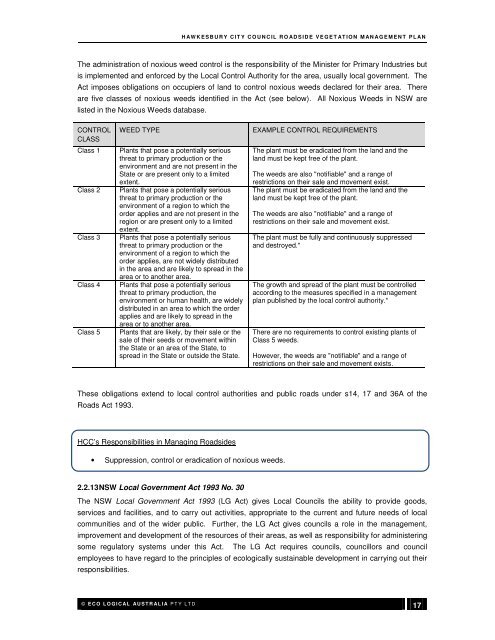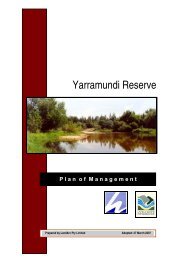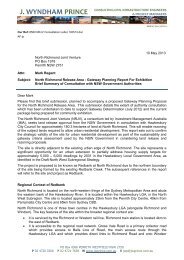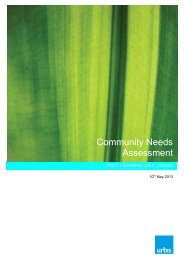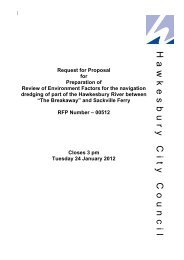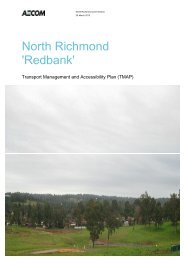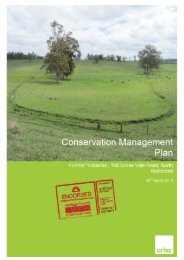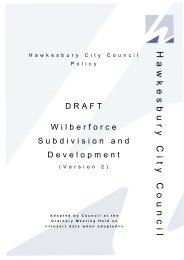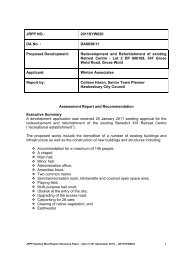Attachment 1 to Item 53 - Roadside Vegetation Management Plan
Attachment 1 to Item 53 - Roadside Vegetation Management Plan
Attachment 1 to Item 53 - Roadside Vegetation Management Plan
You also want an ePaper? Increase the reach of your titles
YUMPU automatically turns print PDFs into web optimized ePapers that Google loves.
H AW K E S B U R Y C IT Y C O U N C IL R O AD S ID E V E G E T AT IO N M AN AG E M E N T P L AN<br />
The administration of noxious weed control is the responsibility of the Minister for Primary Industries but<br />
is implemented and enforced by the Local Control Authority for the area, usually local government. The<br />
Act imposes obligations on occupiers of land <strong>to</strong> control noxious weeds declared for their area. There<br />
are five classes of noxious weeds identified in the Act (see below). All Noxious Weeds in NSW are<br />
listed in the Noxious Weeds database.<br />
CONTROL<br />
CLASS<br />
Class 1<br />
Class 2<br />
Class 3<br />
Class 4<br />
Class 5<br />
WEED TYPE<br />
<strong>Plan</strong>ts that pose a potentially serious<br />
threat <strong>to</strong> primary production or the<br />
environment and are not present in the<br />
State or are present only <strong>to</strong> a limited<br />
extent.<br />
<strong>Plan</strong>ts that pose a potentially serious<br />
threat <strong>to</strong> primary production or the<br />
environment of a region <strong>to</strong> which the<br />
order applies and are not present in the<br />
region or are present only <strong>to</strong> a limited<br />
extent.<br />
<strong>Plan</strong>ts that pose a potentially serious<br />
threat <strong>to</strong> primary production or the<br />
environment of a region <strong>to</strong> which the<br />
order applies, are not widely distributed<br />
in the area and are likely <strong>to</strong> spread in the<br />
area or <strong>to</strong> another area.<br />
<strong>Plan</strong>ts that pose a potentially serious<br />
threat <strong>to</strong> primary production, the<br />
environment or human health, are widely<br />
distributed in an area <strong>to</strong> which the order<br />
applies and are likely <strong>to</strong> spread in the<br />
area or <strong>to</strong> another area.<br />
<strong>Plan</strong>ts that are likely, by their sale or the<br />
sale of their seeds or movement within<br />
the State or an area of the State, <strong>to</strong><br />
spread in the State or outside the State.<br />
EXAMPLE CONTROL REQUIREMENTS<br />
The plant must be eradicated from the land and the<br />
land must be kept free of the plant.<br />
The weeds are also "notifiable" and a range of<br />
restrictions on their sale and movement exist.<br />
The plant must be eradicated from the land and the<br />
land must be kept free of the plant.<br />
The weeds are also "notifiable" and a range of<br />
restrictions on their sale and movement exist.<br />
The plant must be fully and continuously suppressed<br />
and destroyed.*<br />
The growth and spread of the plant must be controlled<br />
according <strong>to</strong> the measures specified in a management<br />
plan published by the local control authority.*<br />
There are no requirements <strong>to</strong> control existing plants of<br />
Class 5 weeds.<br />
However, the weeds are "notifiable" and a range of<br />
restrictions on their sale and movement exists.<br />
These obligations extend <strong>to</strong> local control authorities and public roads under s14, 17 and 36A of the<br />
Roads Act 1993.<br />
HCC’s Responsibilities in Managing <strong>Roadside</strong>s<br />
• Suppression, control or eradication of noxious weeds.<br />
2.2.13 NSW Local Government Act 1993 No. 30<br />
The NSW Local Government Act 1993 (LG Act) gives Local Councils the ability <strong>to</strong> provide goods,<br />
services and facilities, and <strong>to</strong> carry out activities, appropriate <strong>to</strong> the current and future needs of local<br />
communities and of the wider public. Further, the LG Act gives councils a role in the management,<br />
improvement and development of the resources of their areas, as well as responsibility for administering<br />
some regula<strong>to</strong>ry systems under this Act. The LG Act requires councils, councillors and council<br />
employees <strong>to</strong> have regard <strong>to</strong> the principles of ecologically sustainable development in carrying out their<br />
responsibilities.<br />
© E C O L O G I C AL AU S T R AL I A P T Y L T D<br />
17


